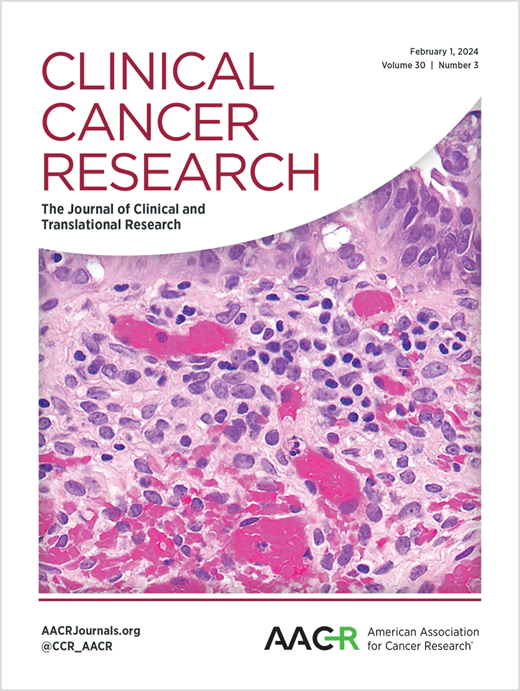紫杉醇单独或联合Pelareorep联合或不联合Avelumab治疗转移激素受体阳性乳腺癌的II期随机研究:bracet -01/PrE0113研究
IF 10
1区 医学
Q1 ONCOLOGY
引用次数: 0
摘要
目的:Pelareorep (Pel)是一种上调PD-L1表达的3型溶瘤呼肠孤病毒。我们测定了紫杉醇(Pac)、Pac + Pel或Pac + Pel + avelumab (Ave)的客观缓解率(ORR)。患者和方法:激素受体阳性(HR+) HER2阴性转移性乳腺癌(MBC)患者,在至少一条cdk4 /6抑制剂的内分泌治疗中取得进展,并且未接受过MBC化疗,符合条件。在确认三联用药的安全性后,患者以1:1:1的比例随机分配到Pac、Pac/Pel或Pac/Pel/Ave。每8周评估一次疗效,直到第16周,然后每12周使用RECIST v1.1评估一次疗效。主要终点为16周的ORR。没有计划对不同武器进行统计比较。结果:48例患者入组,45例随机,Pac、Pac/Pel和Pac/Pel/Ave组的16周ORR分别为20%、31%和14%。Pac、Pac/Pel和Pac/Pel/Ave组的中位无进展生存期(PFS)分别为6.4个月、12.1个月和5.8个月。与Pac组相比,联合用药组出现了更多的不良事件,尤其是输液反应。在Pac/Pel中,通过周期(C)4观察到外周T细胞克隆的扩增,但Pac或Pac/Pel/Ave臂中没有观察到。结论:与Pac相比,向Pac中添加Pel可增加毒性,扩大外周t细胞克隆,并在数值上增加ORR和PFS;Pac/Pel/Ave进一步增加毒性和减弱T细胞反应,但疗效没有明显提高。对Pac/Pel联合用药的研究需要仔细考虑其急性毒性。本文章由计算机程序翻译,如有差异,请以英文原文为准。
A Phase II Randomized Study of Paclitaxel alone or combined with Pelareorep with or without Avelumab in Metastatic Hormone Receptor Positive Breast Cancer: the BRACELET-01/PrE0113 study
Purpose: Pelareorep (Pel) is a type 3 oncolytic reovirus that upregulates PD-L1 expression. We determined the objective response rate (ORR) with paclitaxel (Pac), Pac + Pel, or Pac + Pel + avelumab (Ave). Patients and Methods: Patients with hormone receptor positive (HR+) HER2 negative metastatic breast cancer (MBC) who had progressed on at least one line of endocrine therapy with a CDK 4/6 inhibitor and had not received chemotherapy for MBC were eligible. Patients were randomized 1:1:1 to Pac, Pac/Pel or Pac/Pel/Ave after a three-patient run-in confirmed safety of the triplet. Response was assessed every 8 weeks until week 16 and then every 12 weeks using RECIST v1.1. The primary endpoint was 16-week ORR. Statistical comparison across arms was not planned. Results: 48 patients enrolled with 45 randomized, 16-week ORR was 20%, 31% and 14% in the Pac, Pac/Pel and Pac/Pel/Ave arms, respectively. Median progression-free survival (PFS) was 6.4 months (m), 12.1m and 5.8m in the Pac, Pac/Pel and Pac/Pel/Ave arms respectively. There were more adverse events, particularly infusion reactions, in the combination arms than the Pac arm. Expansion of peripheral T cell clones were observed by cycle (C)4 in Pac/Pel but not the Pac or Pac/Pel/Ave arms. Conclusions: The addition of Pel to Pac was associated with increased toxicity, expanded peripheral T-cell clones, and numerically increased ORR and PFS compared to Pac; Pac/Pel/Ave further increased toxicity and blunted T cell responses without obvious increase in efficacy. Investigation of the Pac/Pel combination warrants consideration with careful attention to acute toxicity.
求助全文
通过发布文献求助,成功后即可免费获取论文全文。
去求助
来源期刊

Clinical Cancer Research
医学-肿瘤学
CiteScore
20.10
自引率
1.70%
发文量
1207
审稿时长
2.1 months
期刊介绍:
Clinical Cancer Research is a journal focusing on groundbreaking research in cancer, specifically in the areas where the laboratory and the clinic intersect. Our primary interest lies in clinical trials that investigate novel treatments, accompanied by research on pharmacology, molecular alterations, and biomarkers that can predict response or resistance to these treatments. Furthermore, we prioritize laboratory and animal studies that explore new drugs and targeted agents with the potential to advance to clinical trials. We also encourage research on targetable mechanisms of cancer development, progression, and metastasis.
 求助内容:
求助内容: 应助结果提醒方式:
应助结果提醒方式:


